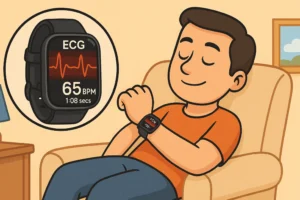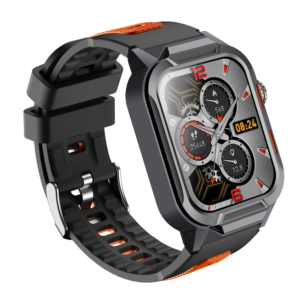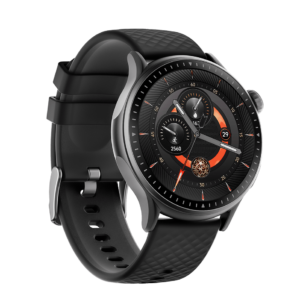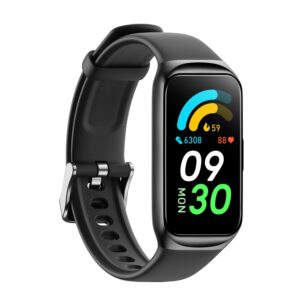When searching for the perfect smartwatch, many consumers look out for waterproofing as they need that protection against dust and water damage. With durability and reliability being major factors that influence purchasing decisions, IP68 is not just a buzzword as it directly impacts customer satisfaction and return rates. But what does it mean? In this blog post, we will explain IP68 water resistance and why it matters for consumers.
What is IP68?
IP68 is a rating system developed by the International Electrotechnical Commission (IEC) to classify the degree of protection against solid objects and water. It indicates how well a electronic device is protected against water and dust.The first number, “IP” stands for “ingress protection” while the second number, “68”, corresponds to the specific level of protection.
The number 6 means that the watch is dust-resistant. So, it is not susceptible to any dust-related damage, which is great for users involved in a lot of hiking or moving through windy areas. The second number, 8, refers to the level of water resistance. A smartwatch with this figure has been tested for its ability to survive in water as deep as 9.8 feet (3m) for up to 30 minutes.
This means that a watch with an IP68 rating will survive a drop in a pool that is not more than ten feet deep, rain splashes and sweaty workouts.
Is IP68 Important for a Smart Watch?
Water-resistance is always an important factor to consider when purchasing any type of electronic device. But for a smartwatch, it is especially important since the watch will likely be worn during activities where it could be exposed to water, such as swimming, sweating during a workout, or being caught in the rain.
No one wants to buy a smartwatch that packs up after a little exposure to water. The simple answer is yes, IP68 is important for a smartwatch.
Different IP Ratings
There are actually different levels of IP68 protection, with the highest level being IP68K. However, most smart watches on the market have an IP68 rating, which is still very good.
Here are the different IP ratings to pay attention to as knowing them will help avoid customer complaints.
| Level | Protection against | Effective against | Details |
|---|---|---|---|
| X | — | — | X means there is no data available to specify a protection rating with regard to these criteria. |
| 0 | None | — | No protection against ingress of water |
| 1 | Dripping water | Dripping water (vertically falling drops) shall have no unsafe effect on the specimen when mounted in an upright position onto a turntable and rotated at 1 RPM. | Test duration: 10 minutes water equivalent to 1 mm (0.039 in) rainfall per minute |
| 2 | Dripping water when tilted at 15° | Vertically dripping water shall have no harmful effect when the enclosure is tilted at an angle of 15° from its normal position. A total of four positions are tested within two axes. | Test duration: 2.5 minutes for every direction of tilt (10 minutes total) Water equivalent to 3 mm (0.12 in) rainfall per minute |
| 3 | Spraying water | Water falling as a spray at any angle up to 60° from the vertical shall have no harmful effect, utilizing either: a) an oscillating fixture or b) A spray nozzle with a counterbalanced shield. Test a) is conducted for 5 minutes, then repeated with the specimen rotated horizontally by 90° for the second 5-minute test. Test b) is conducted (with a shield in place) for 5 minutes minimum. | For a spray nozzle: Test duration: 1 minute per square meter for at least 5 minutes[5] Water volume: 10 liters per minute (0.037 impgal/s) Pressure: 50–150 kPa (7.3–21.8 psi)For an oscillating tube: Test duration: 10 minutes Water volume: 0.07 liters per minute (0.00026 impgal/s) per hole |
| 4 | Splashing of water | Water splashing against the enclosure from any direction shall have no harmful effect, utilizing either:a) an oscillating fixture, or b) A spray nozzle with no shield. Test a) is conducted for 10 minutes. b) is conducted (without shield) for 5 minutes minimum. | Oscillating tube: Test duration: 10 minutes, or spray nozzle (same as IPX3 spray nozzle with the shield removed) |
| 5 | Water jets | Water projected by a nozzle (6.3 mm (0.25 in)) against enclosure from any direction shall have no harmful effects. | Test duration: 1 minute per square meter for at least 3 minutes later volume: 12.5 liters per minute Pressure: 30 kPa (4.4 psi) at a distance of 3 meters (9.8 ft) |
| 6 | Powerful water jets | Water projected in powerful jets (12.5 mm (0.49 in)) against the enclosure from any direction shall have no harmful effects. | Test duration: 1 minute per square meter for at least 3 minutes later volume: 100 liters per minute (0.37 impgal/s) Pressure: 100 kPa (15 psi) at a distance of 3 meters (9.8 ft) |
| 6K | Powerful water jets with increased pressure | Water projected in powerful jets (6.3 mm (0.25 in the) nozzle) against the enclosure from any direction, under elevated pressure, shall have no harmful effects. Found in DIN 40050, and not IEC 60529. | Test duration: at least 3 minutes Water volume: 75 liters per minute (0.27 impgal/s) Pressure: 1,000 kPa (150 psi) at distance of 3 meters (9.8 ft) |
| 7 | Immersion, up to 1 meter (3 ft 3 in) depth | Ingress of water in harmful quantity shall not be possible when the enclosure is immersed in water under defined conditions of pressure and time (up to 1 meter (3 ft 3 in) of submersion). | Test duration: 30 minutes.[3]Tested with the lowest point of the enclosure 1,000 mm (39 in) below the surface of the water, or the highest point 150 mm (5.9 in) below the surface, whichever is deeper. |
| 8 | Immersion, 1 meter (3 ft 3 in) or more depth | The equipment is suitable for continuous immersion in water under conditions that shall be specified by the manufacturer. However, with certain types of equipment, it can mean that water can enter but only in such a manner that it produces no harmful effects. The test depth and duration is expected to be greater than the requirements for IPx7, and other environmental effects may be added, such as temperature cycling before immersion. | Test duration: Agreement with manufacturer depth specified by the manufacturer, generally up to 3 meters (9.8 ft) |
Is IP68 Waterproofing Worth the Investment?

IP68 smartwatches are not like regular watches. They have tougher casings and better water-resistant seals. However, compared to lower-rated models, the extra effort put into making them durable and waterproof with reinforced casings reflects in the pricing. Therefore, IP68-rated smartwatches are more expensive than non-waterproof alternatives.
Still, when you think about all the benefits associated with selling these models, you’ll realize that it’s a safer long-term investment for businesses aiming to sell quality products with fewer to no complaints after sale. The trick is pricing your IP68 smartwatches competitively while still keeping a good profit margin.
Why Sell IP68 Smart Watches?
Since most IP68-rated smartwatches are associated with better durability and reliability, consumers are usually willing to pay a premium for them. Therefore, it’s all about catering to niche markets that need these durable wearables including athletes, outdoor enthusiasts and adventure lovers. For them, water resistance is very important.
Some of the advantages of selling waterproof smartwatches are:
- The smartwatches typically last longer, which could lead to repeat customers and brand loyalty. More customers will be willing to spread the word about your products when they are assured of the high-quality smartwatches you offer.
- Businesses can charge premium due to higher perceived value.
- Fewer complaints about water damage means that there will be lower return rates which is definitely great for business.
What About IP67, IP68, and 3ATM Ratings?
To be honest, IP67 and IP68 water resistance have become standard features in smartwatches. However, this is only a pointer that higher waterproof rating offers more value for consumers. None of these ratings are ideal for swimming, diving or prolonged water exposure, and that’s where the 3ATM rating or higher comes in.
For sellers looking to differentiate their products and boost profitability, it’s a great idea to invest in smartwatches with a 3ATM rating. It offers a broader appeal to fitness enthusiasts who want higher water resistance in their wearables. That’s a good opportunity to expand your customer base beyond casual users.
Get More Profit by Selling 3ATM+ Smart Watches
Want your smartwatch collection to stand out and earn more profits? Amazon sellers or retail stores can get more profit from high waterproof rating smartwatches or fitness trackers as these are key selling points in marketplaces.
A smartwatch with 3ATM+ water resistance, like the GTX2 GPS outdoor smartwatch, stands out among standard IP67 and IP68 models, being able to withstand water pressure up to 30 meters. That means your customers can wear them while swimming, showering, or even running in the rain—no need to take them off. It’s a feature fitness lovers and outdoor enthusiasts actively look for, because they want gear that keeps up with their lifestyle.
By including smartwatches with 3TAM or higher waterproof ratings in your lineup, you’ll gain more loyal buyers—those who value quality, tend to be more loyal, and are often happy to pay a premium. So, highlight this in your product listings to attract tech-savvy buyers and position your store as a premium brand. Plus, they’re more likely to leave great reviews or recommend your store to others.
Here’s how offering 3ATM+ watches can help your business grow:
- Expand your audience. Swimmers, runners, hikers, and people who work in wet environments will naturally be drawn to your products.
- Outshine competitors. While most sellers stick to IP68 models, you can showcase the benefits of both and highlight what sets yours apart.
- Strengthen your brand. High-performance products help position your store as a reliable destination for premium fitness and lifestyle gear.
- Boost profit margins. These models often sell at higher prices, and customers understand they’re paying for durability and performance.
Can an IP Rating Become Void?
What happens when a customer returns a smartwatch within a few months, claiming that it suffered water damage as against what was advertised? It’s important to ask the right questions or you may suffer significant losses due to multiple returns. Usually, most manufacturers state how long the rating is expected to last for, with most being around 2 years.
However, the manner of usage can shorten this time. Some actions that can void an IP rating are:
- Using the smartwatch in a hot tub or sauna can break its seal.
- Exposure to salt water or chlorine for extended periods
- Punctures on the watch that could remove its seal
In conclusion, IP68-rated smartwatches are waterproof devices that fit most lifestyle needs and are in high demand. They are worth looking into.



















